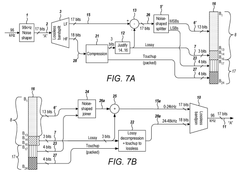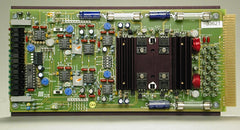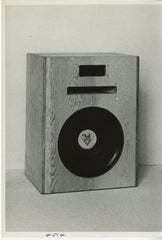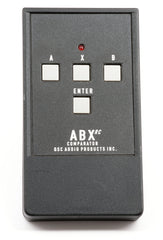Buy one component and save 10% on up to 2 cables. Buy 2 components and get 4 free cables. Free shipping on USA orders over $700. Low-cost shipping to Canada.
Buy one component and save 10% on up to 2 cables. Buy 2 components and get 4 free cables. Free shipping on USA orders over $700. Low-cost shipping to Canada.
Audio Application Notes
AHB2 Tri-Amp Setup - Ellery Coffman
by Benchmark Media Systems July 27, 2017
The following photos and system descriptions were provided to us by one of our customers, Ellery Coffman. He has put together an amazing system and has carefully treated his room with acoustic absorbers. Nicely done!
Hi Rory,
Thanks again for your help. For two speakers, it is truly unbelievable how real this tri-amp system sounds; it is nothing short of jaw dropping! It truly sounds better than the $200k+ setups I've heard in some of the high-end audio shops I've been to.
Post updated 10/8/2020
Speaker Sensitivity and Amplifier Power
by John Siau April 27, 2017
Speaker sensitivity is a measure of how loud a speaker will play at a given input power or at a given input voltage. Sensitivity is normally measured with a 1 watt power input or a 2.83 Vrms voltage input.
There have been many different speaker designs over the years and there are vast differences in speaker sensitivity. The speakers below have sensitivities ranging from about 85 dB to 109 dB.
- What are the power requirements?
- What are the implications for system noise?
- How loud will each play?
- Do they require different amplifiers?
- John Siau
Audio Myths - The Ultimate "Myth Buster" Video - Monty Montgomery, Xiph.Org
by John Siau March 14, 2017
Digital Show & Tell, Monty Montgomery, Xiph.org
Monty Montgomery takes us into the lab and uses a series of simple demonstrations to bust some very common myths about digital audio. Test your knowledge of digital audio. This video is fun to watch and easy to understand! Monty takes some difficult concepts and demonstrates them in a clear and simple manner.
Have doubts about Nyquist? Have a fear of stairsteps? Are you worried about ringing? Ever wonder what digital audio does to the timing of transients? This video is for you!
Myth - "Digital audio has stairsteps."
Myth - "Increased bit depths reduce the stairsteps."
Myth - "Analog tape has more resolution than digital audio."
Myth - "Dither masks quantization noise."
Myth - "Signals lower than one LSB cannot be reproduced."
Myth - "Digital filters make square waves and impulses ring."
Myth - "Digital systems cannot resolve timing between samples."
Intersample Overs in CD Recordings
by John Siau February 10, 2017
Intersample Overs are a Common Occurrence in CD Recordings
We have frequently used Steely Dan's Gaslighting Abbie from Two Against Nature in our listening tests. This is a spectacular CD recording with lots of dynamics and a low noise floor. Nevertheless, in a little over 5 minutes, this track has 559 intersample overs on the left track and 570 on the right track for a total of 1129. This means that there are about 3.7 intersample overs per second. The highest intersample over measures +0.8 dBFS. The track itself is not clipped, the 44.1 kHz sampling has simply captured peaks that exceed 0 dBFS. The following image shows the track with the intersample overs highlighted in red:
This track can be played cleanly by the Benchmark DAC2 and DAC3 converters. These converters accurately render the intersample peaks that were captured in the recording process. In contrast, conventional converters will clip each of the peaks highlighted in red. In this track the peaks coincide with hits to the snare drum. Converters that clip these peaks add a false brightness to the snare drum and alter its sound.
- John Siau
A Look Inside the New ES9028PRO Converter Chip and the New DAC3
by John Siau November 14, 2016
ES9028PRO D/A Converter Chip - Block Diagram and Test Report
This application note examines the differences between the ES9018 and the new ES9028PRO. It also compares the Benchmark DAC2 and DAC3 to demonstrate the performance improvements that can be achieved in a commercial product. It has been a little over 7 years since ESS Technology introduced the revolutionary ES9018 audio D/A converter chip. This converter delivered a major improvement in audio conversion and, for 7 years, it has held its position as the highest performing audio D/A converter chip. But a new D/A chip has now claimed this top position. Curiously the successor did not come from a competing company; it came from ESS. On October 19, 2016, ESS Technology announced the all-new ES9028PRO 32-bit audio D/A converter. In our opinion, ESS is now two steps ahead of the competition!
- John Siau
Calculating the Performance of an Amplifier-Speaker Combination
by John Siau November 01, 2016
Example 1 - PMC IB2S
In this application note we calculate the maximum output level and noise level produced by an amplifier/loudspeaker combination. Use this example for calculating the performance of your system.
At the 141st AES conference we demonstrated two Benchmark AHB2 monoblock power amplifiers driving a pair of 4-Ohm PMC IB2S studio monitors. These monitor are also available the PMC IB2SE hi-fi version.
In bridged mono, the AHB2 can deliver over 518 watts into each of these 4-Ohm speakers. This is a perfect match to PMC's 500 watt recommendation. The AHB2 easily provides the power, the output current, and the damping required by these low-impedance speakers.
"I am very impressed with the clarity and accuracy of these outstanding professional monitors. The Benchmark AHB2 and PMC IB2S are an absolutely killer combination!"
- John Siau, VP, Benchmark Media Systems, Inc.
Power Amplifiers - A "First Watt" ABX Test
by John Siau September 27, 2016
In Benchmark's listening room we recently demonstrated the importance of the first watt using two 100 watt stereo power amplifiers. One amplifier was a traditional class-AB amplifier, the other was Benchmark's AHB2 power amplifier with feed-forward error correction. Using a double-blind ABX test, we verified that there was a clearly audible difference when the amplifiers drove speakers at an output level of 0.01 watt.
- John Siau
Audio Myth - Balanced Headphone Amplifiers are Better
by John Siau September 15, 2016
THIS MYTH GOES SOMETHING LIKE THIS:
"Balanced headphone amplifiers are better."
"If balanced line-level connections work well, balanced headphone outputs should also work well."
We disagree!
Benchmark does not offer balanced headphone outputs on any of its products. The reason for this is that a voltage-balanced interface serves no useful purpose when driving headphones. The truth is that a conventional single-ended headphone drive is technically superior to a balanced drive. This paper explains why single-ended headphone amplifiers are inherently more transparent than balanced headphone amplifiers.
-John Siau
Inside the DAC2 - Part 3 - Power Supplies
by John Siau July 13, 2016
The Benchmark DAC2 is an audio digital-to-analog converter. This application note explains the power supply configuration inside Benchmark's DAC2 D/A converter. In part 1 of this series we discussed the importance of the analog section of an audio converter. In part 2 we discussed the unique high-headroom digital processing chain inside the DAC2. The analog and digital systems each contribute toward Benchmark's overall goal of transparent musical reproduction, but this goal can only be reached when these systems are supported by a well-designed power supply system. In many cases, classic solutions (linear power supplies, line-frequency transformers, and large banks of capacitors) fail to deliver adequate performance. The DAC2 takes a radically different approach.
- John Siau
Inside the DAC2 - Part 2 - Digital Processing
by John Siau June 24, 2016
The Benchmark DAC2 is an audio digital-to-analog converter. This application note explains the proprietary digital processing inside Benchmark's DAC2 D/A converter. In part 1 of this series we made the case that 90% of the components in an audio converter are analog, and that about 90% of the "magic" happens in the analog processing. Nevertheless the 10% that is digital still makes an audible contribution to the sound of an audio D/A converter. This is especially true when the digital processing is complemented by a very pure and clean analog section. With a highly transparent analog section, some of the subtleties of the digital processing can become apparent.
Take a tour of the digital processing chain in the DAC2.
- John Siau
Inside the DAC2 - Part 1 - Analog Processing
by John Siau June 04, 2016
The DAC2 is an audio digital-to-analog converter. Most people focus on the word "digital" and assume that all of the "magic" happens in the digital processing, but nothing could be further from the truth! A look inside most audio converters would show that about 90% of the components are analog!
This application note takes a look at the analog processing in Benchmark's DAC2 D/A converter.
- John Siau
The PLL in your D/A Can Taint A/B Listening Tests!
by John Siau June 03, 2016
A/B and A/B/X listening tests are important methods of comparing two audio sources or two audio components. In the studio an engineer may want to switch an effect or EQ setting on and off to decide if it contributes positively to a mix. Hi-Fi enthusiasts may wish to compare audio components, signal sources and interconnects. The DAC1 and DAC2 converters have input selector switches that allow fast and easy switching between signal sources. Before attempting to conduct these tests, it is important to understand how these converters and their switches work. A/B tests using the DAC1 input selector can be very misleading. In contrast, A/B testing using the input selector on the DAC2 will produce reliable results. This application note provides guidance for conducting reliable A/B or A/B/X listening tests with your D/A converter.
- John Siau
Grounding XLR Connectors - Neutrik USA
by John Siau June 01, 2016
"Neutrik is often asked whether the shiny silver tab (pictured below) on typical XLR cable connectors (Neutrik XX series, RX series, X series, etc.) should be connected to anything."
"In the course of the evolution of the AV industry, it has come to be that this tab is practically never terminated. This means, in turn, that the shell is not grounded. When in doubt, simply leave this tab unterminated."
"Whether or not they are internally wired to the shield signal, XLR cable connector shells always make an electrical connection to chassis connector shells once the two are mated."
"Typically, chassis connectors need to be grounded. The industry best practice is generally to tie all of the chassis connector shell, pin 1, and the enclosure shield to a common ground."
- John Siau
Is MQA DOA?
by John Siau May 05, 2016
The truth is that we may add MQA to the list of audio formats that have come and gone. This list includes HDCD, DVDA, and DSD. All three of these claimed to deliver some sort of sonic improvement, but all three have suffered from a lack of content. HDCD and the DVDA are dead while DSD may be on its death bed. All three were supported by hardware but have died due to a lack of recordings in these formats. It should be noted that the DVDA did bring us high resolution audio formats and these have survived while the DVDA itself has died. Two dead, one dying ... is MQA next?

To those of us who are interested in the best possible musical playback, the small details are important. The promise of "improved sound" always catches our attention ...
- John Siau
Audio Myth - "Switching Power Supplies are Noisy"
by John Siau May 03, 2016
This Myth Goes Something Like This:
"Switching supplies are noisy."
"Linear power supplies are best for audio."
We disagree!
About 5 years ago, Benchmark stopped putting linear power supplies into our new products, and we replaced them with switching power supplies. We did this because linear supplies are too noisy. Yes, you read that correctly, linear supplies are noisy!
A well-designed switching power supply can be much quieter than a linear supply!
Find out why!
- John Siau
Benchmark Bi-Directional 12 Volt Trigger - Technical Details
by John Siau April 20, 2016
12 Volt Trigger
Link your audio products together with trigger cables


Benchmark has created a bi-directional 12 Volt trigger interface that is compatible with almost every trigger input and output. This interface can be used to connect Benchmark products together so that they will power up and down in a sequenced fashion. This same interface can be connected to the trigger inputs and outputs on other brands of audio products. This application note describes some typical configurations and it includes the full technical details of the Benchmark bi-directional trigger system.
- John Siau
Benchmark ... The Measure of Excellence®
by Benchmark Media Systems March 19, 2016
A benchmark is a standard or point of measurement to which other things can be compared.
As our name implies, we are committed to excellence. Our products often define the current state-of-the-art in terms of audio performance.
Benchmark products are designed and built by audio enthusiasts. We are musicians, audiophiles and audio professionals who are passionate about audio quality. We also are passionate about the durability and build quality of our products. Most of our products are designed, assembled, tested, and shipped worldwide from our headquarters in Syracuse, NY, USA, where we have been for over 40 years.
Our goal is to build top-quality sonically-transparent products that you will enjoy for years to come.
- John Siau, VP, Benchmark Media Systems
History of the AHB2 Power Amplifier
by John Siau March 18, 2016
The DA101 - Inspiration for the AHB2

For many years, we used our distribution amplifiers to drive the speakers in our listening room. We couldn't buy an amplifier that came close to the performance of our distribution amplifiers, and Allen had often talked about building a bigger amplifier that could match the performance of the DA101.
In 2011 we began to talk about making Allen's dream for a power amp a reality. The goal was to meet or exceed the performance of Allen's DA101, while scaling up the power by a factor of 10.
- John Siau
The A.H.B. Story
by John Siau March 17, 2016
A.H.B.
The AHB2 power amplifier is named in honor of Benchmark's founder, Allen H. Burdick. Allen had a life-long passion for audio, and became one of the leading innovators in the pro-audio industry. Allen was a perfectionist and a prolific engineer. Most early Benchmark schematics bear the initials A.H.B.
Allen's DA101 distribution amplifier helped define the performance goals of the AHB2 power amplifier. The result is an amplifier that Allen would have been proud to call a "Benchmark".
In loving memory of Allen H. Burdick (June 29, 1942 - September 27, 2013).
- John Siau
Made in USA - A Video Tour of Benchmark's Manufacturing Operations
by John Siau March 16, 2016
Designed, Assembled, and Tested in the USA
Since 1983, Benchmark products have been designed, assembled, and tested in the USA. Our products are now shipped to every continent, but we are firmly committed to keeping our manufacturing in the USA.
Watch us transform a solid bar of aluminum into a finished Benchmark faceplate. Learn how sheets of metal are formed into finished enclosures. Watch as hundreds of tiny electronic components are accurately placed on circuit boards. See the chassis and electronic components converge at final assembly where each product is hand assembled. Watch our technicians run a comprehensive sequence of performance and safety tests.
- John Siau
























